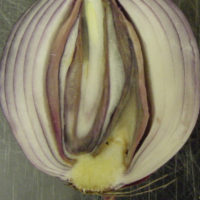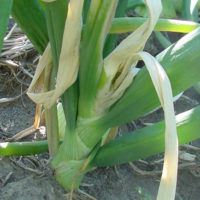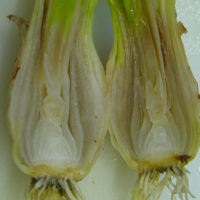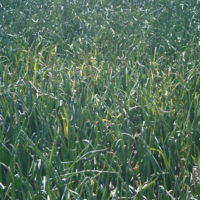Stop the Rot
Onion bulb crops are grown on approximately 140,000 acres/year in seven primary regions of the U.S., with a farm-gate value of $925M. Bacterial diseases of onion cause more than $60M in losses annually to this industry. Losses can be particularly severe for stored bulbs as bacterial rots typically develop in storage, after all production costs have been incurred.
This ‘Stop the Rot’ project organizes 24 scientists in diverse disciplines across the U.S. to research the complete system (host, pathogen, environment) of bacterial diseases of onion. The aim is to develop practical, economically sound strategies for pathogen detection and management that will improve profitability and sustainability of onion production.
The project has two primary research objectives:
A: National survey across all onion growing regions, so that we can compare the genomics of onion bacterial pathogens collected in different regions to:
- identify virulence factors
- develop practical molecular diagnostic tools for identifying specific bacterial pathogens
- develop phenotypic resistance screening methods
B: Through research trials, identify onion production practices, environmental factors and inoculum sources that impact bacterial diseases, then use this knowledge to develop effective, practical solutions for managing bacterial diseases.

This work is supported by Specialty Crops Research Initiative Award 2019-51181-30013 from the USDA National Institute of Food and Agriculture. Any opinions, findings, conclusions, or recommendations expressed in this publication are those of the author(s) and do not necessarily reflect the view of the U.S. Department of Agriculture.
New Onion World Magazine article, in the May/June 2022 issue:
A Collaborative Effort: Joint Allium Research Meeting Showcases Latest Research on Onion Production, Pests, Diseases.
Stop the Rot annual project team meeting will be on March 1, 2022 in Denver, CO. See the meeting page for details.
Stop the Rot annual Stakeholder Advisory Panel videoconference will be on March 25, 2022. More information will be sent to panel members nearer the time.
Stop the Rot Team Newsletter – September 2020
- To disinfect or not? Can postharvest applications of disinfectants reduce bacterial bulb rots in storage? Article by Lindsey du Toit and Tim Waters in Onion World magazine, July/August 2021. Onion World Magazine July/August 2021
- Two critical pieces of the puzzle: Irrigation & nitrogen management impacts on bacterial bulb rots. Article by Gabriel LaHue in Washington State University’s Onion Alert bulletin, September 2021.
- Bacterial Bulb Rot Diseases in Utah. Article by Claudia Nischwitz in the Utah Pests Quarterly Newsletter, Vol. 15, Spring 2021.
- Progress report on the Stop the Rot Project, in Onion World magazine, May/June 2021.
- Onion disease management in Georgia. Article by Bhabesh Dutta in Vegetable and Specialty Crop News, February 2021.
Resources
View the complete list of Stop the Rot publications and resources
Grower FAQs about bacterial diseases of onions
Videos
Did you know we have a Stop the Rot video playlist on YouTube? Bookmark the link and find new videos there, including these:
- “How Do We Stop the Rot?”This extension video from the Washington State University team provides an overview of bacterial diseases of onion and information on management of factors causing disease, as well as more about the Stop the Rot project.
- Two extension videos on basics of onion bacterial rots, produced by the Cornell team. English Spanish
Extension bulletins
- Bacterial Disease of Onions in Georgia (August 2020). Bhabesh Dutta and Ron Gitaitis provide a comprehensive outlook on specific symptoms associated with bacterial diseases, modes of infection and spread, and potential management options.
Technical reports
- Collated summaries of Year 1 Technical Reports for Stop the Rot (August 2021) provides an overview of the Year 1 program of work and preliminary results of project research.
- Plant Disease Management Reports for Seasons 1, 2, and 3 are now available, covering results of field trials in 2020, 2021, and 2022, respectively, from multiple states, including Colorado, Georgia, New York, and Washington
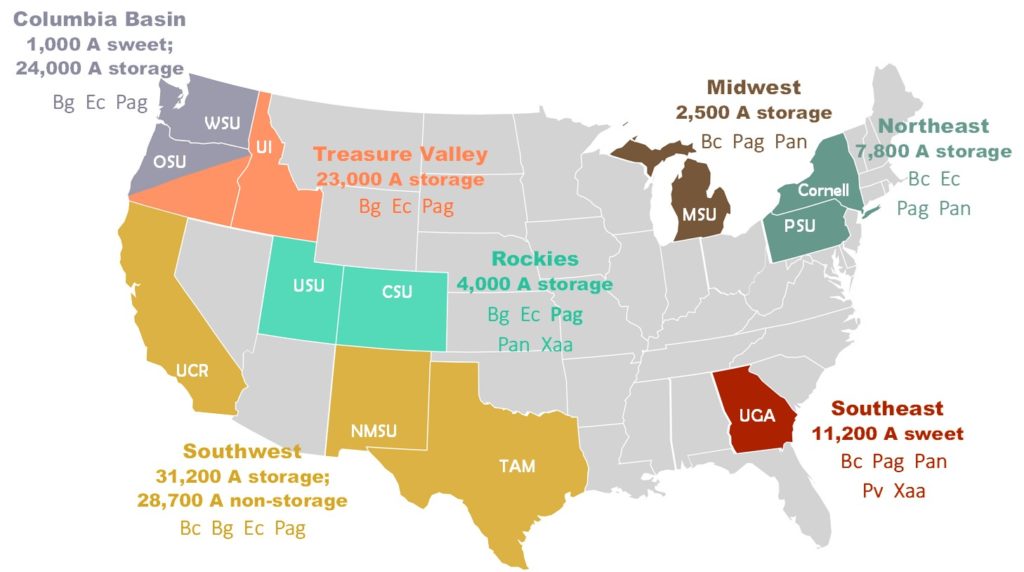
Bacterial diseases of onion occur across the U.S. They are difficult to manage due to a lack of effective, rapid detection methods, relatively poor understanding of the diversity and epidemiology of bacterial pathogens, and a lack of systemic bactericides that can treat these diseases and mitigate losses to the industry. In addition, there are few or no known resistant commercial cultivars.
We know from research and trials that a number of factors favor the development of bacterial diseases. These factors include:
- Contaminated seed and transplants
- Storm damage, rain, hail, frost damage
- Mechanical wounds, insects (thrips), weeds
- Irrigation – runoff, excess, overhead irrigation
- Excessive fertility, especially post-bulb initiation
- Moderate to high temperatures (>30oC), except for some Pseudomonas (cool to warm)
- Dense plant stands
- Some topping, curing, and handling practices
- Insect pests – maggot, thrips
- Weeds – symptomatic & asymptomatic hosts



